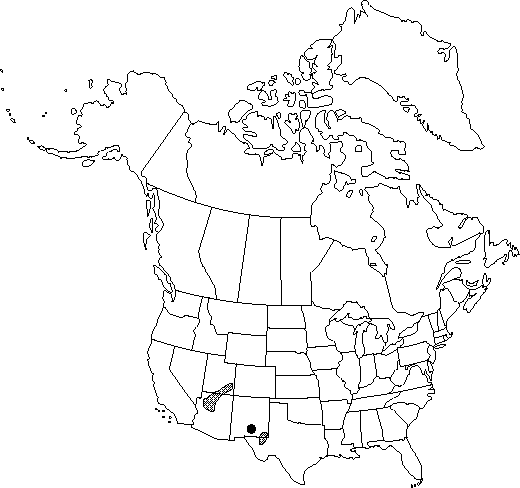Difference between revisions of "Ostrya knowltonii"
Gard. & Forest 7: 114. 1894.
FNA>Volume Importer |
imported>Volume Importer |
||
| (7 intermediate revisions by 2 users not shown) | |||
| Line 14: | Line 14: | ||
|basionyms= | |basionyms= | ||
|synonyms={{Treatment/ID/Synonym | |synonyms={{Treatment/ID/Synonym | ||
| − | |name= | + | |name=Ostrya baileyi |
|authority=Rose | |authority=Rose | ||
| + | |rank=species | ||
}} | }} | ||
|hierarchy=Betulaceae;Betulaceae subfam. Coryloideae;Ostrya;Ostrya knowltonii | |hierarchy=Betulaceae;Betulaceae subfam. Coryloideae;Ostrya;Ostrya knowltonii | ||
| Line 24: | Line 25: | ||
}}<!-- | }}<!-- | ||
| − | --><span class="statement" id="st- | + | --><span class="statement" id="st-undefined" data-properties=""><b>Trees,</b> to 9 m; crowns open, narrowly rounded. <b>Bark</b> brownish gray, broken into narrow vertical scales or rather ragged strips. <b>Twigs</b> sparsely to moderately pubescent, often with stipitate glands. <b>Leaves</b>: petiole covered with stipitate glands. <b>Leaf</b> blade ovate or broadly ovate-elliptic to broadly elliptic or nearly orbiculate, 2.5–6.5 × 1.5–5 cm, base narrowly rounded to cordate or cuneate, margins sharply and unevenly doubly serrate, apex acute; surfaces abaxially pubescent, especially on veins. <b>Inflorescences</b>: staminate catkins 2–3 cm; pistillate catkins 0.6–1 cm. <b>Infructescences</b> 2.5–4 × 1.8–2.5 cm; bracts 1–1.8 × 0.5–1 cm.</span><!-- |
-->{{Treatment/Body | -->{{Treatment/Body | ||
| Line 31: | Line 32: | ||
|elevation=1200–2400 m | |elevation=1200–2400 m | ||
|distribution=Ariz.;N.Mex.;Tex.;Utah. | |distribution=Ariz.;N.Mex.;Tex.;Utah. | ||
| − | |discussion=<p>Ostrya knowltonii occurs sporadically throughout the arid Southwest, including both rims of the Grand Canyon. On the basis of morphology and phytogeography, it appears to be more closely allied with Ostrya in mountainous western Mexico than with the eastern O. virginiana.</p> | + | |discussion=<p><i>Ostrya knowltonii</i> occurs sporadically throughout the arid Southwest, including both rims of the Grand Canyon. On the basis of morphology and phytogeography, it appears to be more closely allied with <i>Ostrya</i> in mountainous western Mexico than with the eastern <i>O. virginiana</i>.</p> |
|tables= | |tables= | ||
|references= | |references= | ||
| Line 40: | Line 41: | ||
-->{{#Taxon: | -->{{#Taxon: | ||
name=Ostrya knowltonii | name=Ostrya knowltonii | ||
| − | |||
|authority=Coville | |authority=Coville | ||
|rank=species | |rank=species | ||
|parent rank=genus | |parent rank=genus | ||
| − | |synonyms= | + | |synonyms=Ostrya baileyi |
|basionyms= | |basionyms= | ||
|family=Betulaceae | |family=Betulaceae | ||
| Line 55: | Line 55: | ||
|publication year=1894 | |publication year=1894 | ||
|special status=Endemic | |special status=Endemic | ||
| − | |source xml=https:// | + | |source xml=https://bitbucket.org/aafc-mbb/fna-data-curation/src/2e0870ddd59836b60bcf96646a41e87ea5a5943a/coarse_grained_fna_xml/V3/V3_224.xml |
|subfamily=Betulaceae subfam. Coryloideae | |subfamily=Betulaceae subfam. Coryloideae | ||
|genus=Ostrya | |genus=Ostrya | ||
|species=Ostrya knowltonii | |species=Ostrya knowltonii | ||
| − | |||
| − | |||
| − | |||
| − | |||
| − | |||
| − | |||
| − | |||
| − | |||
| − | |||
| − | |||
| − | |||
| − | |||
| − | |||
| − | |||
| − | |||
| − | |||
| − | |||
| − | |||
| − | |||
| − | |||
| − | |||
| − | |||
}}<!-- | }}<!-- | ||
-->[[Category:Treatment]][[Category:Ostrya]] | -->[[Category:Treatment]][[Category:Ostrya]] | ||
Latest revision as of 22:47, 5 November 2020
Trees, to 9 m; crowns open, narrowly rounded. Bark brownish gray, broken into narrow vertical scales or rather ragged strips. Twigs sparsely to moderately pubescent, often with stipitate glands. Leaves: petiole covered with stipitate glands. Leaf blade ovate or broadly ovate-elliptic to broadly elliptic or nearly orbiculate, 2.5–6.5 × 1.5–5 cm, base narrowly rounded to cordate or cuneate, margins sharply and unevenly doubly serrate, apex acute; surfaces abaxially pubescent, especially on veins. Inflorescences: staminate catkins 2–3 cm; pistillate catkins 0.6–1 cm. Infructescences 2.5–4 × 1.8–2.5 cm; bracts 1–1.8 × 0.5–1 cm.
Phenology: Flowering late spring.
Habitat: Streamsides and rocky slopes in moist canyons
Elevation: 1200–2400 m
Distribution

Ariz., N.Mex., Tex., Utah.
Discussion
Ostrya knowltonii occurs sporadically throughout the arid Southwest, including both rims of the Grand Canyon. On the basis of morphology and phytogeography, it appears to be more closely allied with Ostrya in mountainous western Mexico than with the eastern O. virginiana.
Selected References
None.